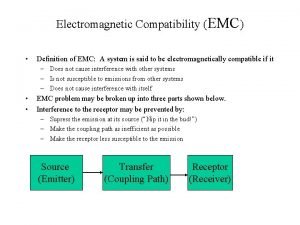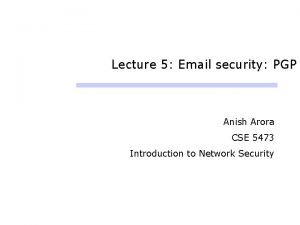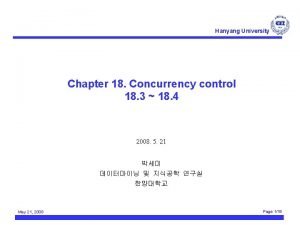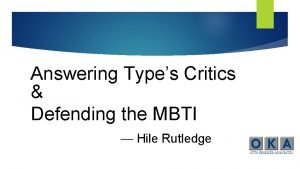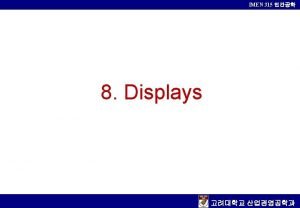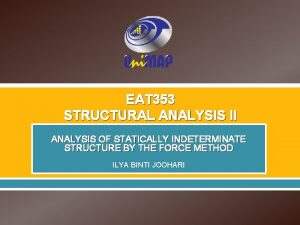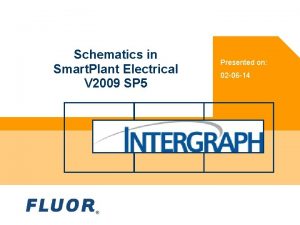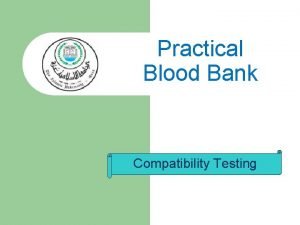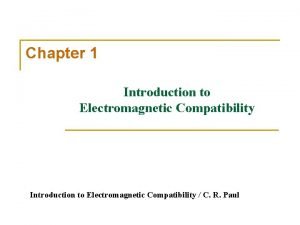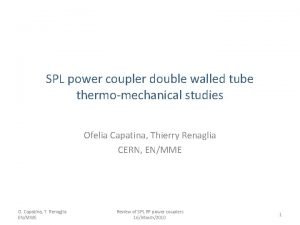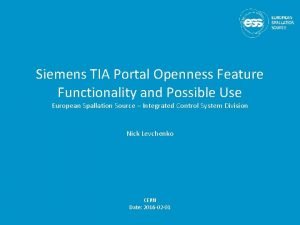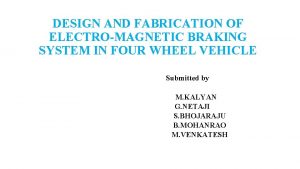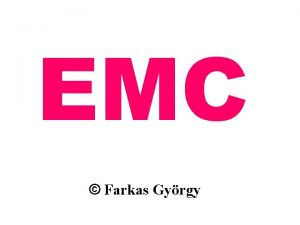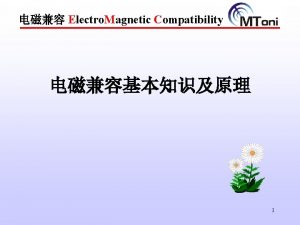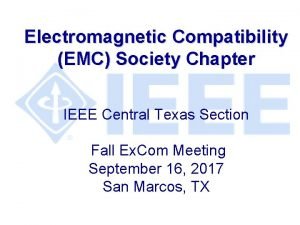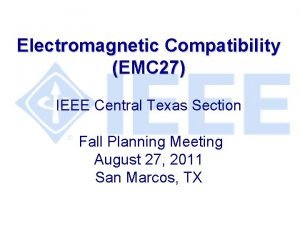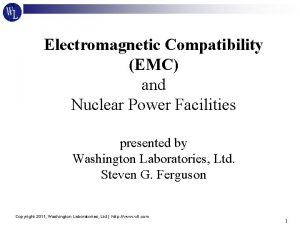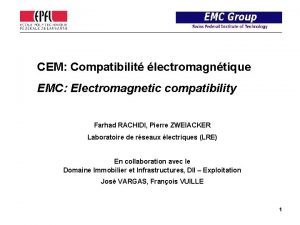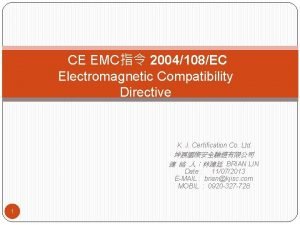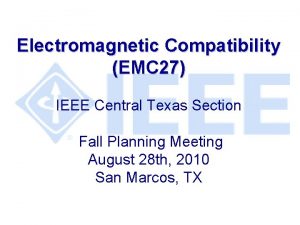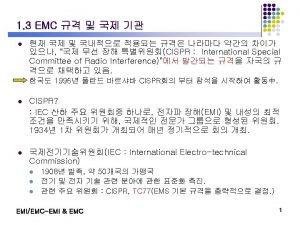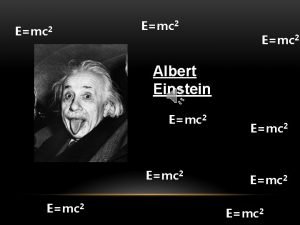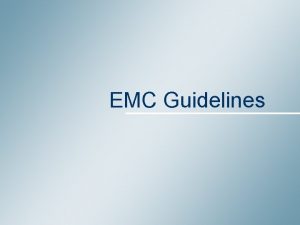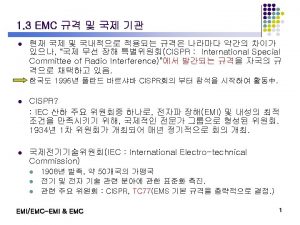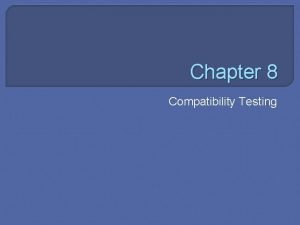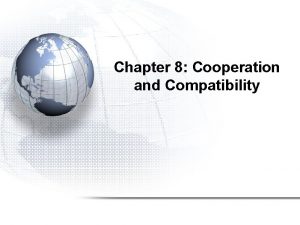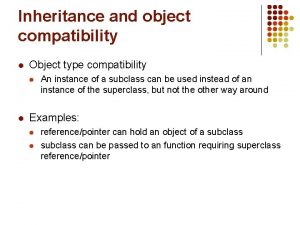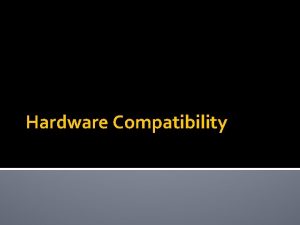Electromagnetic Compatibility EMC Definition of EMC A system

Electromagnetic Compatibility (EMC) • Definition of EMC: A system is said to be electromagnetically compatible if it – Does not cause interference with other systems – Is not susceptible to emissions from other systems – Does not cause interference with itself • • EMC problem may be broken up into three parts shown below. Interference to the receptor may be prevented by: – Supress the emission at its source (“Nip it in the bud!”) – Make the coupling path as inefficient as possible – Make the receptor less susceptible to the emission Source (Emitter) Transfer (Coupling Path) Receptor (Receiver)

Four EMC Sub-problems:

Other aspects of EMC

Electrical Length of a wire “k” is how long the wire is in terms of wavelengths k = L / λ (unitless) where L = physical length of wire in meters and λ = wavelength, which is the length of one complete period of the wave at some instant of time as it propagates away from the emitter λ = v * T = v / f where v = velocity of propagation of an EM wave (m/s) T = period of the wave (time it takes for the emitter to generate one complete period of the wave. ) Measured in seconds. f = frequency of the wave = number of complete periods generated by the source per second, f = 1/T. (Measured in Hertz = 1/s).

Speed of EM wave in free space (air): v = 1/sqrt(εOμO) = 3 x 108 m/s where εO = permittivity of free space = 1/(36π) x 10 -9 F/m μO = permeability of free space = 4 π x 10 -7 H/m For a material medium: v = 1/sqrt(εOεRμOμR) for a medium with relative permeability μR and relative permittivity εR both of which range between 1 and infinity. Thus v is always slower in a material medium compared to free space.

For a non-magnetic medium μR = 1. 0 Example: Find the electrical length of a 10 cm wire in air at a frequency of 5000 MHz: k = 10*10 -2 m / [(3*108 m/s) / 5000*106 1/s)] = 1. 667 wavelengths In Bakelite: k = 10*10 -2 m / [{(3*108 m/s) / sqrt(1*4. 74)}/ 5000*106 1/s)] = 3. 63 wavelengths

Emitter and receptor coupling is most efficient when their dimensions are on the order of a wavelength. As products are made to operate faster and faster, their operating frequencies of products increase. Thus a wavelength becomes smaller and smaller, and even physically small products become efficient receptors and radiators at the frequencies at which they operate. Therefore…. EMC problems are on the rise!

Wavelengths at different frequencies in AIR Note wavelength in meters = v / f = 300 / f. MHZ NOTE: As CPU clock and bus frequencies rise above 3 GHz, very short lengths of interconnecting wires become efficient radiators / receptors. . Increasing EMC problems for the computer engineer!


Performance, Pricing and Availability Pentium® 4 Extreme Edition 3. 46 GHz, Nov. 1, 2004 Core Speed Level Two Cache Size System Bus Speed 1 KU Price 3. 46 GHz 2 MB level 3 1, 066 MHZ $999 Intel® Xeon™ processor 3. 2 GHz 1000 K 800 MHZ $? ? Intel® Pentium® 4 Procesor 2. 80 GHz 512 K 533 MHZ $508 Intel® Pentium® 4 Procesor 2. 66 GHz 512 K 533 MHz $401 Intel® Pentium® 4 Procesor 2. 60 GHz 512 K 400 MHz $401 Pentium® 4 Extreme Edition

Speeds of PC Components • • • 3. 5 GHz Pentium 4 (announced on 28 August 2001) 533 MHz PC system bus 800 MHz DDRAM, RDRAM • 1 -GHz DSP chip from TI, 1 -19 -2004 • 6 -Gbit/s backplane from PMC-Sierra, LSI Logic, Accelerant, Rambus, 2 -2 -2004 • • 3. 46 GHz Pentium 4, August 28, 2001 800 MHz PC system bus 800 MHz DDRAM, RDRAM 1, 066 MHz front-side bus for Pentium 4, November 1, 2004

Speeds of Backplane and Networks • • • 10 -Gbit/second Ethernet over Category 5 e cable demo, March 22, 2004 10 -Gbit/, s Backplane design, April 8, 2004 The selector chip operating at 50 Gbit/s uses a circuit schematic that takes 1. 0 V power, standard for 90 -nm CMOS chips, Fujitsu, March 23, 2004

Wireless Devices • • • • Cordless Phones – 900 MHz, 2. 4 GHz (Digital Spread Spectrum) Walkie Talkie – 467 MHz Analog Cell Phone, AMPS: Advanced Mobile Phone Service – 800 MHz CDMA: Code Division Multiple Access – 800 MHz or 1900 MHz DCS-1800: European 1800 MHz GSM band. PCS: Personal Communication Services – 1900 MHz TRI-BAND – GSM phone at 900 MHz, 1800 MHz, and 1900 MHz. GSM: Global System for Mobile communications. Most wireless LANs currently use the 2. 4 to 2. 48 GHz band. ISM: Industrial Scientific and Medical Unlicensed Frequency Bands - Operates at 900 MHz and 2. 4 GHz. MMDS: Multi-channel Multi-point Distribution Service, a fixed wireless service for data, voice and video which operates in the 2. 5 GHz band in North America and in the 3. 5 GHz bandwidth internationally. The Bluetooth system is operating in the 2. 4 GHz ISM band. IEEE 802. 11 – 2. 4 GHz; 802. 11 g – 5 GHz


The Digital Hub as Gateway (IEEE Spectrum July 2002)

The Core of A Home Entertainment Hub (IEEE Spectrum July 2002)

Building Safer Cars

Building Safer Cars

One subset of a modern vehicle’s network • Expanding Autopmotive Electronic Sysmtes, IEEE Computer, Jan. 2002



- Slides: 22

